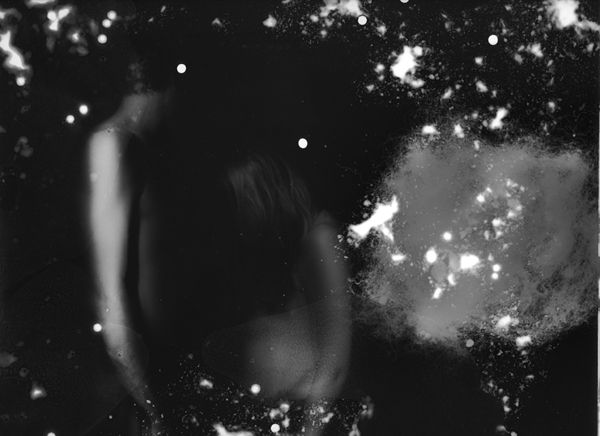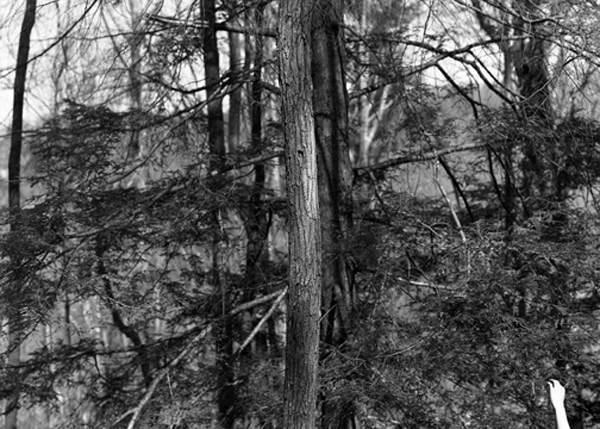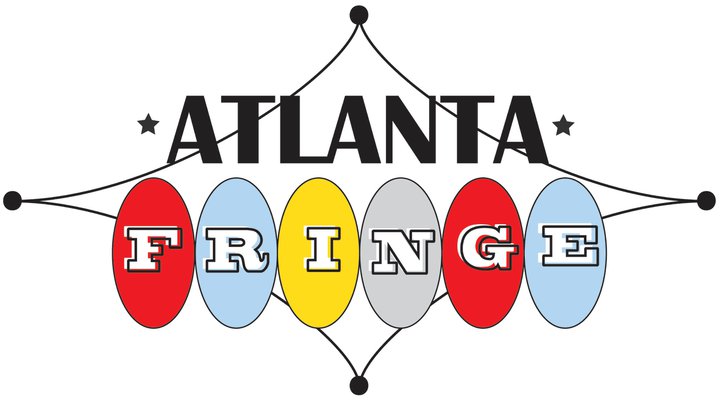Stephanie Dowda is the kind of person who seems to make time materialize by force of thought. She co-founded local photography collective Click Clique and helped establish the Photographer’s Print Studio, a community darkroom co-op. When she isn’t curating or organizing some of Atlanta’s most innovative art shows, she’s an insightful and disciplined photographer in her own right. As she told Dashboard Co-op, “I identify mostly with being an artist; but part of my art includes making a community for it to exist in, and to be part of a community that I am inspired from.”
CommonCreativ sat down on a piece of cardboard with Dowda inside her Boom City space to discuss philosophy, photography, and the way she haunts things.
CommonCreativ: Your background is in photography. How’d you fall in love with the medium?
Stephanie Dowda: I got into photography when I was a teenager, then at Georgia State, [where] I majored in philosophy and minored in photography. At State, I learned a lot of analog and traditional processes, which I still carry through today. I have a darkroom studio, and film is really important to me.
CC: What has it been like as a member of the growing arts community in Atlanta?SD: In my last year of school, I came to this realization: What am I going to do when I get out of school? At that time, Wonderroot didn’t exist, and there was no black-and-white darkroom rental in town. I thought, not only where am I supposed to do my work, but also what am I supposed to do as a young artist in the city? I decided if there were no obvious opportunities, I should just create them. So I started with this really great core group of friends who were all photo majors, who all worked really hard and photographed a lot. So I started the Click Clique photo collective, and we did these events that were photo-based, free and open to everyone. At first we didn’t have venues—we met at parks and did it online or made zines. Then slowly, as smaller galleries were emerging, we were asked to do shows at Beep Beep Gallery or Youngblood. That was motivating as I got out of school, and simultaneously put me on the map as being an artist. I was also able to curate a lot of stuff and still do today.
CC: What made you decide to do solo work as a Dashboard artist?
SD: I guess the motivation was that I’ve done a lot within the community, and I’ve been on a lot of boards, and I’ve done my own stuff too, but I wanted 2013 to be the year that I focused on what I was able to do [as an artist rather than a curator] by myself. And obviously, Dashboard provides an amazing network of people. There were like five people in here earlier helping me build this mountain.
CC: A show like Boom City creates a new kind of conversation between artists and the Atlanta community. What’s your take on it?
SD: I think what’s remarkable about Dashboard is this reinvigoration and reinvention of space and time. They’re always highlighting artists who put the effort into taking themselves to the next level, but also finding those people that have a lot of potential, and I think they do it in such a smart and sexy way that it lets people realize why a particular artist is important and why their work is really unique, but also why we should be spending our time coming to art shows. It’s also a different experience that I don’t think a lot of people get to have: Being able to come downtown to Underground and being able to come into this crazy building and see how it’s transformed—it begins to show the possibility—not just in the talent and what can happen in Atlanta, but in terms of what can happen in your everyday life.CC: What relationship does your art have with the city?
SD: I feel very fortunate to have been born and raised in Atlanta. It’s been so interesting and difficult and exciting to watch Atlanta grow, and to be part of that growth in some way. The kinds of issues that you can tackle as an artist—social issues or injustices—we think about economic divides, we think about race and religion, politics. I’ve recently gone through some difficult things in confronting illness and death, and I think that it’s also kind of a gift to be able to translate that into something that can contribute to how we think about our lives and struggles.
CC: Tell me about some of the thoughts and influences that have led you to this piece for Boom City.
SD: I take reading, literature, and philosophy as a point of departure in my work. I’ll read e.e. cummings and say, “I should go photograph that.” Instead of seeking out a text to make my work from, I did a reexamination of my work until now, to try to figure out if there are common themes. I tried to use landscape and environments as a place where other things are happening—unsaid things, emotive qualities, poetic qualities that were somehow captured in the landscape.
CC: Like the Emily Dickinson quote “Nature is a haunted house—but art is a house that tries to be haunted.”SD: Exactly. That might have involved putting people in [the landscapes], might have involved me climbing a mountain and shooting. I had this thought that the environment, beyond aesthetics, was supposed to resonate as something more. So I started thinking: “I wonder if this is an idea,” and lo and behold, it is. There’s a professor at Wisconsin State University who in the 1960s coined the term “topophilia,” which essentially is the love or the wisdom from the earth, from geography. I wanted to play with that, so I started photographing places that I may not have had a profound experience in, but were very meaningful.
CC: How does the idea of creating a manufactured landscape play into these philosophies?
SD: I’m interested in—kind of based on this show I just curated at Georgia State [Shadow Puppets: Traces of New Documentary Practices at the Welsh School Galleries]—the idea of using reality as a tool to come to a greater sense. Using manipulation of what is seemingly real in a false way—like the fable idea—you tell a story to somebody and we are enriched from the lesson learned. So I’m mixing this topophilia sense with re-creating or manipulating reality to enhance something. And how you’re both being affected by this environment, this installation, and affecting it. How that can be both real and not real.
Boom City will be showing through March 2nd on Mondays and Wednesdays from 6 to 9pm in the MRich Building, 115 Martin Luther King Jr Drive SW.



!["Topophilia 30707 Forget it" Photo Credit: Stephanie Dowda <br> [c/o Dashboard Co-op]](http://commoncreativatlanta.com/wp-content/uploads/2013/02/Topophilia-30707-Forget-it-photo-credit-Stephanie-Dowda-courtesy-of-Dashboard-Co-op.jpg)





